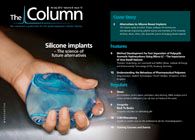Method Development for Fast Separation of Polycyclic Aromatic Hydrocarbons Using Micro-LC - The Importance of the Dwell Volume
The Column
This article will shed some light on recent developments of micro-LC and the possibility of applying fast separations while reducing toxic and costly solvent waste.
Over the years there has been an on-going trend for miniaturization in life sciences. There is a similar trend in the field of chromatography. Some manufacturers have already introduced new devices on the basis of chip‑technology. Unfortunately, progress is very slow and many users are searching for “bridge technologies” like micro-LC. Although the instrumentation has matured, many practitioners are still prejudiced against micro‑LC because of long-standing notions of irreproducible gradient formation and a low robustness of commercially available instruments. This article will therefore shed some light on recent developments of micro‑LC and the possibility of applying fast separations while reducing toxic and costly solvent waste.

Extracting Estrogenic Hormones Using Rotating Disk and Modified Clays
April 14th 2025University of Caldas and University of Chile researchers extracted estrogenic hormones from wastewater samples using rotating disk sorption extraction. After extraction, the concentrated analytes were measured using liquid chromatography coupled with photodiode array detection (HPLC-PDA).
Polysorbate Quantification and Degradation Analysis via LC and Charged Aerosol Detection
April 9th 2025Scientists from ThermoFisher Scientific published a review article in the Journal of Chromatography A that provided an overview of HPLC analysis using charged aerosol detection can help with polysorbate quantification.
Removing Double-Stranded RNA Impurities Using Chromatography
April 8th 2025Researchers from Agency for Science, Technology and Research in Singapore recently published a review article exploring how chromatography can be used to remove double-stranded RNA impurities during mRNA therapeutics production.









